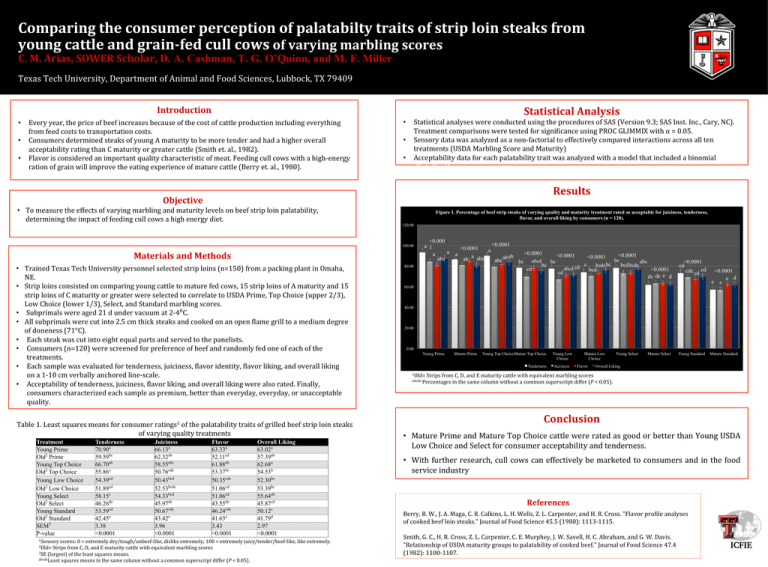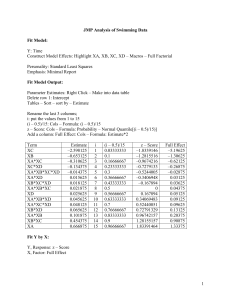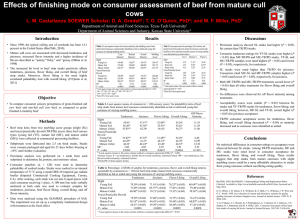Document 11414839
advertisement

Comparing the consumer perception of palatabilty traits of strip loin steaks from young cattle and grain-­‐fed cull cows of varying marbling scores C. M. Arias, SOWER Scholar, D. A. Cashman, T. G. O’Quinn, and M. F. Miller Texas Tech University, Department of Animal and Food Sciences, Lubbock, TX 79409 Introduction Statistical Analysis • Every year, the price of beef increases because of the cost of cattle production including everything from feed costs to transportation costs. • Consumers determined steaks of young A maturity to be more tender and had a higher overall acceptability rating than C maturity or greater cattle (Smith et. al., 1982). • Flavor is considered an important quality characteristic of meat. Feeding cull cows with a high-­‐energy ration of grain will improve the eating experience of mature cattle (Berry et. al., 1980). Objective • To measure the effects of varying marbling and maturity levels on beef strip loin palatability, determining the impact of feeding cull cows a high energy diet. Materials and Methods • Trained Texas Tech University personnel selected strip loins (n=150) from a packing plant in Omaha, NE. • Strip loins consisted on comparing young cattle to mature fed cows, 15 strip loins of A maturity and 15 strip loins of C maturity or greater were selected to correlate to USDA Prime, Top Choice (upper 2/3), Low Choice (lower 1/3), Select, and Standard marbling scores. • Subprimals were aged 21 d under vacuum at 2-­‐4⁰C. • All subprimals were cut into 2.5 cm thick steaks and cooked on an open Rlame grill to a medium degree of doneness (71°C). • Each steak was cut into eight equal parts and served to the panelists. • Consumers (n=120) were screened for preference of beef and randomly fed one of each of the treatments. • Each sample was evaluated for tenderness, juiciness, Rlavor identity, Rlavor liking, and overall liking on a 1-­‐10 cm verbally anchored line-­‐scale. • Acceptability of tenderness, juiciness, Rlavor liking, and overall liking were also rated. Finally, consumers characterized each sample as premium, better than everyday, everyday, or unacceptable quality. • Statistical analyses were conducted using the procedures of SAS (Version 9.3; SAS Inst. Inc., Cary, NC). Treatment comparisons were tested for signiRicance using PROC GLIMMIX with α = 0.05. • Sensory data was analyzed as a non-­‐factorial to effectively compared interactions across all ten treatments (USDA Marbling Score and Maturity) • Acceptability data for each palatability trait was analyzed with a model that included a binomial error distribution. 120.00 100.00 80.00 60.00 40.00 of varying quality treatments Treatment Young Prime Old2 Prime Young Top Choice Old2 Top Choice Young Low Choice Old2 Low Choice Young Select Old2 Select Young Standard Old2 Standard SEM3 P-value Tenderness 70.90a 59.59bc 66.70ab 55.86c 54.39cd 51.89cd 58.15c 46.26de 53.59cd 42.45e 3.38 <0.0001 Juiciness 66.13a 62.32ab 58.55abc 50.76cde 50.43bcd 52.53bcde 54.33bcd 45.97de 50.67cde 43.42e 3.96 <0.0001 Flavor 63.33a 52.11cd 61.88ab 53.37bc 50.35cde 51.06cd 51.06cd 43.55de 46.24cde 41.63e 3.43 <0.0001 Overall Liking 63.02a 57.39ab 62.68a 54.53b 52.30bc 53.39bc 55.64ab 45.87cd 50.12c 41.79d 2.97 <0.0001 1Sensory scores: 0 = extremely dry/tough/unbeef-­‐like, dislike extremely; 100 = extremely juicy/tender/beef-­‐like, like extremely. 2Old= Strips from C, D, and E maturity cattle with equivalent marbling scores 3SE (largest) of the least squares means. abcdeLeast squares means in the same column without a common superscript differ (P < 0.05). Figure 1. Percentage of beef strip steaks of varying quality and maturity treatment rated as acceptable for juiciness, tenderness, flavor, and overall liking by consumers (n = 120). <0.000 a 1 a a abc <0.0001 <0.0001 a <0.0001 a <0.0001 <0.0001 ab a abc <0.0001 ab abc bc b ab bc abcd bc abc c bc bcd bc bcde bcde cd abcd cd <0.0001 bcd cd de de e d <0.0001 cd cde cd cd <0.0001 e d e e 20.00 0.00 Young Prime Mature Prime Young Top Choice Mature Top Choice Tenderness Young Low Choice Juiciness Mature Low Choice Flavor Young Select Mature Select Young Standard Mature Standard Overall Liking 1Old= Strips from C, D, and E maturity cattle with equivalent marbling scores abcde Percentages in the same column without a common superscript differ (P < 0.05). Conclusion Table 1. Least squares means for consumer ratings1 of the palatability traits of grilled beef strip loin steaks Results • Mature Prime and Mature Top Choice cattle were rated as good or better than Young USDA Low Choice and Select for consumer acceptability and tenderness. • With further research, cull cows can effectively be marketed to consumers and in the food service industry References Berry, B. W., J. A. Maga, C. R. Calkins, L. H. Wells, Z. L. Carpenter, and H. R. Cross. "Flavor proRile analyses of cooked beef loin steaks." Journal of Food Science 45.5 (1980): 1113-­‐1115. Smith, G. C., H. R. Cross, Z. L. Carpenter, C. E. Murphey, J. W. Savell, H. C. Abraham, and G. W. Davis. "Relationship of USDA maturity groups to palatability of cooked beef." Journal of Food Science 47.4 (1982): 1100-­‐1107.





